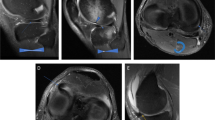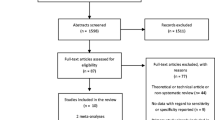Abstract
Purpose
To compare diagnostic performance of a 5-min knee MRI protocol to that of a standard knee MRI.
Materials and methods
One hundred 3 T (100 patients, mean 38.8 years) and 50 1.5 T (46 patients, mean 46.4 years) MRIs, consisting of 5 fast, 2D multi-planar fast-spin-echo (FSE) sequences and five standard multiplanar FSE sequences, from two academic centers (1/2015–1/2016), were retrospectively reviewed by four musculoskeletal radiologists. Agreement between fast and standard (interprotocol agreement) and between standard (intraprotocol agreement) readings for meniscal, ligamentous, chondral, and bone pathology was compared for interchangeability. Frequency of major findings, sensitivity, and specificity was also tested for each protocol.
Results
Interprotocol agreement using fast MRI was similar to intraprotocol agreement with standard MRI (83.0–99.5%), with no excess disagreement (≤ 1.2; 95% CI, −4.2 to 3.8%), across all structures. Frequency of major findings (1.1–22.4% across structures) on fast and standard MRI was not significantly different (p ≥ 0.215), except more ACL tears on fast MRI (p = 0.021) and more cartilage defects on standard MRI (p < 0.001). Sensitivities (59–100%) and specificities (73–99%) of fast and standard MRI were not significantly different for meniscal and ligament tears (95% CI for difference, −0.08–0.08). For cartilage defects, fast MRI was slightly less sensitive (95% CI for difference, −0.125 to −0.01) but slightly more specific (95% CI for difference, 0.01–0.5) than standard MRI.
Conclusion
A fast 5-min MRI protocol is interchangeable with and has similar accuracy to a standard knee MRI for evaluating internal derangement of the knee.




Similar content being viewed by others
References
Oei EH, Nikken JJ, Verstijnen AC, Ginai AZ, Myriam Hunink MG. MR imaging of the menisci and cruciate ligaments: a systematic review. Radiology. 2003;226(3):837–48.
Rangger C, Klestil T, Kathrein A, Inderster A, Hamid L. Influence of magnetic resonance imaging on indications for arthroscopy of the knee. Clin Orthop Relat Res. 1996;330:133–42.
Cheung LP, Li KC, Hollett MD, Bergman AG, Herfkens RJ. Meniscal tears of the knee: accuracy of detection with fast spin-echo MR imaging and arthroscopic correlation in 293 patients. Radiology. 1997;203(2):508–12.
Mackenzie R, Palmer CR, Lomas DJ, Dixon AK. Magnetic resonance imaging of the knee: diagnostic performance studies. Clin Radiol. 1996;51(4):251–7.
Quatman CE, Hettrich CM, Schmitt LC, Spindler KP. The clinical utility and diagnostic performance of magnetic resonance imaging for identification of early and advanced knee osteoarthritis: a systematic review. Am J Sports Med. 2011;39(7):1557–68.
Zhang M, Min Z, Rana N, Liu H. Accuracy of magnetic resonance imaging in grading knee chondral defects. Arthroscopy. 2013;29(2):349–56.
Harris JD, Brophy RH, Jia G, Price B, Knopp M, Siston RA, et al. Sensitivity of magnetic resonance imaging for detection of patellofemoral articular cartilage defects. Arthroscopy. 2012;28(11):1728–37.
Figueroa D, Calvo R, Vaisman A, Carrasco MA, Moraga C, Delgado I. Knee chondral lesions: incidence and correlation between arthroscopic and magnetic resonance findings. Arthroscopy. 2007;23(3):312–5.
Kijowski R, Blankenbaker DG, Davis KW, Shinki K, Kaplan LD, De Smet AA. Comparison of 1.5- and 3.0-T MR imaging for evaluating the articular cartilage of the knee joint. Radiology. 2009;250(3):839–48.
Blaimer M, Breuer F, Mueller M, Heidemann RM, Griswold MA, Jakob PM. SMASH, SENSE, PILS, GRAPPA: how to choose the optimal method. Top Magn Reson Imaging. 2004;15(4):223–36.
Glockner JF, Hu HH, Stanley DW, Angelos L, King K. Parallel MR imaging: a user’s guide. Radiographics. 2005;25(5):1279–97.
Harris PA, Taylor R, Thielke R, Payne J, Gonzalez N, Conde JG. Research electronic data capture (REDCap): a metadata-driven methodology and workflow process for providing translational research informatics support. J Biomed Inform. 2009;42(2):377–81.
De Smet AA, Tuite MJ. Use of the “two-slice-touch” rule for the MRI diagnosis of meniscal tears. AJR Am J Roentgenol. 2006;187(4):911–4.
Nguyen JC, De Smet AA, Graf BK, Rosas HG. MR imaging-based diagnosis and classification of meniscal tears. Radiographics. 2014;34(4):981–99.
Hong SH, Choi JY, Lee GK, Choi JA, Chung HW, Kang HS. Grading of anterior cruciate ligament injury: diagnostic efficacy of oblique coronal magnetic resonance imaging of the knee. J Comput Assist Tomogr. 2003;27(5):814–9.
Cosgarea AJ, Jay PR. Posterior cruciate ligament injuries: evaluation and management. J Am Acad Orthop Surg. 2001;9(5):297–307.
Wind WM Jr, Bergfeld JA, Parker RD. Evaluation and treatment of posterior cruciate ligament injuries: revisited. Am J Sports Med. 2004;32(7):1765–75.
Brittberg M, Peterson L. Introduction to an articular cartilage classification. ICRS Newsl. 1998;1:5–8.
Obuchowski NA, Subhas N, Schoenhagen P. Testing for interchangeability of imaging tests. Acad Radiol. 2014;21(11):1483–9.
Pruessmann KP, Weiger M, Boesiger P. Sensitivity encoded cardiac MRI. J Cardiovasc Magn Reson. 2001;3(1):1–9.
Zech CJ, Herrmann KA, Huber A, Dietrich O, Stemmer A, Herzog P, et al. High-resolution MR-imaging of the liver with T2-weighted sequences using integrated parallel imaging: comparison of prospective motion correction and respiratory triggering. J Magn Reson Imaging. 2004;20(3):443–50.
Heidemann RM, Ozsarlak O, Parizel PM, Michiels J, Kiefer B, Jellus V, et al. A brief review of parallel magnetic resonance imaging. Eur Radiol. 2003;13(10):2323–37.
Kijowski R, Rosas H, Samsonov A, King K, Peters R, Liu F. Knee imaging: rapid three-dimensional fast spin-echo using compressed sensing. J Magn Reson Imaging. 2017;45:1712–22. https://doi.org/10.1002/jmri.25507.
Lustig M, Donoho D, Pauly JM. Sparse MRI: the application of compressed sensing for rapid MR imaging. Magn Reson Med. 2007;58(6):1182–95.
Vasanawala SS, Alley MT, Hargreaves BA, Barth RA, Pauly JM, Lustig M. Improved pediatric MR imaging with compressed sensing. Radiology. 2010;256(2):607–16.
Barth M, Breuer F, Koopmans PJ, Norris DG, Poser BA. Simultaneous multislice (SMS) imaging techniques. Magn Reson Med. 2016;75(1):63–81.
Moeller S, Yacoub E, Olman CA, Auerbach E, Strupp J, Harel N, et al. Multiband multislice GE-EPI at 7 tesla, with 16-fold acceleration using partial parallel imaging with application to high spatial and temporal whole-brain fMRI. Magn Reson Med. 2010;63(5):1144–53.
Feinberg DA, Setsompop K. Ultra-fast MRI of the human brain with simultaneous multi-slice imaging. J Magn Reson. 2013;229:90–100.
Jaspan ON, Fleysher R, Lipton ML. Compressed sensing MRI: a review of the clinical literature. Br J Radiol. 2015;88(1056):20150487.
Takahashi M, Uematsu H, Hatabu H. MR imaging at high magnetic fields. Eur J Radiol. 2003;46(1):45–52.
Magee T, Shapiro M, Williams D. Usefulness of simultaneous acquisition of spatial harmonics technique for MRI of the knee. AJR Am J Roentgenol. 2004;182(6):1411–5.
Kreitner KF, Romaneehsen B, Krummenauer F, Oberholzer K, Muller LP, Duber C. Fast magnetic resonance imaging of the knee using a parallel acquisition technique (mSENSE): a prospective performance evaluation. Eur Radiol. 2006;16(8):1659–66.
Doria AS, Chaudry GA, Nasui C, Rayner T, Wang C, Moineddin R, et al. The use of parallel imaging for MRI assessment of knees in children and adolescents. Pediatr Radiol. 2010;40(3):284–93.
Pakin SK, Xu J, Schweitzer ME, Regatte RR. Rapid 3D-T1rho mapping of the knee joint at 3.0T with parallel imaging. Magn Reson Med. 2006;56(3):563–71.
Zuo J, Li X, Banerjee S, Han E, Majumdar S. Parallel imaging of knee cartilage at 3 Tesla. J Magn Reson Imaging. 2007;26(4):1001–9.
Rubenstein JD, Li JG, Majumdar S, Henkelman RM. Image resolution and signal-to-noise ratio requirements for MR imaging of degenerative cartilage. AJR Am J Roentgenol. 1997;169(4):1089–96.
Link TM, Majumdar S, Peterfy C, Daldrup HE, Uffmann M, Dowling C, et al. High resolution MRI of small joints: impact of spatial resolution on diagnostic performance and SNR. Magn Reson Imaging. 1998;16(2):147–55.
Author information
Authors and Affiliations
Corresponding author
Ethics declarations
Conflict of interest
N.O: Siemens AG Research Consultant, Elucid Bioimaging Inc. (unrelated, no conflict for this research study), SG: Federal Grant, Agency for Healthcare Research and Quality (unrelated, no conflict for this research study), NS: Research Grant, Siemens AG (unrelated, no conflict for this research study). The remainder of the authors have no conflict of interest to disclose.
Rights and permissions
About this article
Cite this article
Alaia, E.F., Benedick, A., Obuchowski, N.A. et al. Comparison of a fast 5-min knee MRI protocol with a standard knee MRI protocol: a multi-institutional multi-reader study. Skeletal Radiol 47, 107–116 (2018). https://doi.org/10.1007/s00256-017-2780-9
Received:
Revised:
Accepted:
Published:
Issue Date:
DOI: https://doi.org/10.1007/s00256-017-2780-9




